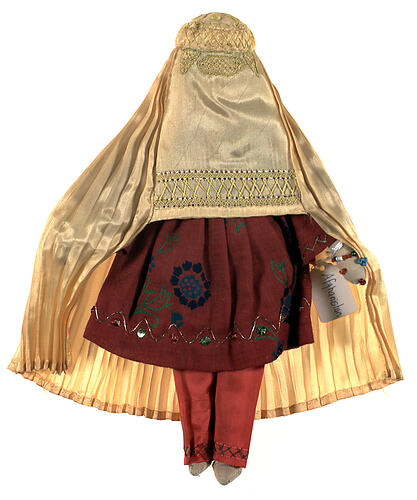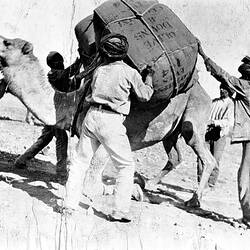Summary
National doll produced to represent an Afghan woman wearing a headcovering which is either a yashmak or chadri. It was given to Monica Gates by her mother who purchased it at the Kabul bazaar on an overland camping trip from London to India in 1978.
The yashmak is a headcovering which contains both a head and face veil, it traditionally consists of two pieces of fine muslin, one tied across the face over the nose supported by a small piece of gold, silver or ivory, and the other tied across the forehead draping the head. However a piece of black horsehair attached near the temples and sloping down like an awning to cover the face could also be used for the face veil.
The chadri is an enveloping pleated garment which covers the wearer's entire face except for a small region about the eyes, which is covered by a concealing net or grille. It is usually sewn from light materials, often in blue, saffron yellow or white. It was originally worn only by upper class Afghan women, then later by servants and villages, as several Afghan government's made moves towards modernisation, with the wives' of the royal family and government officials reverting to wearing the chaadar (partial headcovering) or a smaller veil such as the yashmak. Wearing the chadri became compulsory for women under the Taliban.
Traditional women's costume in Afghanistan consists of a dress, matching trousers, headscarf (chaadar) and flat shoes. Traditionally dresses are colourful and heavily embroidered, with colours and styles varying between regions.
The Gates collection contains 170 national dolls from 74 different countries and some correspondence relating to the acquisition of several of the dolls. The costumes of the dolls represent national costumes from the 19th Century to the 1990s. Monica Gates collected or was given these dolls between 1957 and 1990.
These dolls were purchased as souvenirs of particular countries and like many mass produced souvenirs they are often not accurate representations of a particular country or region, and may actually better reflect neighbouring counties or regions. This occurs because costumes are often stylised and simplified resulting dolls wearing generic costume elements which are common to many countries/regions. Often the fabrics and decorations used are selected to make the dolls cheap and easy to manufacture and aesthetically pleasing. This can result in the fabrics, colours and decorations of the doll's clothing having little or no reflection of the costume associated with a particular country or region they are meant to be representative of.
Physical Description
Female doll wearing a red dress patterned with flowers and with embroidery around the hem. She has a head dress which veils her face and most of her torso at the front and which come to her ankles at the back. It is yellow and has some yellow decorative embroidery on the top and front. Under the dress are long red pants with green, decorative stitching at the bottom. She has beads decorating her hands, wrists, neck, ears and hair. Her hair is black and is tie in two plaits at the back. Her facial features have been sewn on and she wears no shoes.
More Information
-
Collecting Areas
Clothing & Textiles, Childhood, Migration & Cultural Diversity
-
Acquisition Information
Purchase
-
Place Made
-
User
-
Other Association (See Comments)
Afghanistan
Doll is intended to represent an Afghani woman. -
Classification
-
Category
-
Discipline
-
Type of item
-
overall dimensions
21 cm (Length), 6 cm (Width), 28 cm (Height)
-
Keywords
Children's Play, Clothing, Cultural Awareness, Cultural Beliefs, Dolls, National Costumes, National Identity, Religions: Islam, Souvenirs

